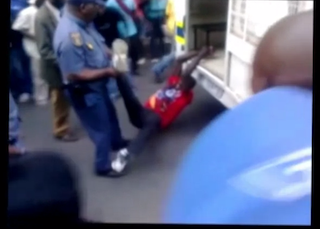At the National Conference on Media Reform earlier this month, a topic I heard repeated in panel after panel was the diversity of voices. Media consolidation, industry cutbacks, and political repression are among the threats to reporting on and by independent and diverse perspectives around the world.
The videos we see on a regular basis from across the globe illustrate the potential of citizen reporters to not only document under-reported stories, but to do so from corners of the globe that have long been inaccessible to reporters as well as human rights investigators and aid groups.
The ability to hear and see breaking news from these regions presents an incredible opportunity, but plenty of challenges as well. For citizen witnesses to safely and effectively document crises, whether in Timbuktu or Ducati Park, they need the tools and skills to film, and their potential audiences need a way of finding, understanding, and trusting their video.
Our mission at the Human Rights Channel is not only to verify and distribute citizen videos, but to find meaning in what are often blurry, fleeting images. We find that meaning in a video’s content, but also in its backstory. Where it is from? How was it taken? How did this, of the thousands of videos uploaded to YouTube each day, make it before our eyes?
The video of an Occupy Wall Street protest, for example, is to be expected. The video of a protest in rural Iran, where farmers clashed with security forces over water shortages last month, is not. The Iranian regime has been known to track down activists spotted on YouTube.
In the past few weeks, we’ve seen several videos from places that are often thought of as closed off or, simply, forgotten. When religious tensions in central Myanmar turned violent in late March, citizen videos helped alert the international media to the burning of Muslim villages and displacement of thousands of people. When a secessionist militia attacked a mining town in the Democratic Republic of Congo, a local reporter narrated the scene on his cell phone, filming dead bodies before running from the shooting.
Moving Beyond Information Overload
For the media and news consumers, the deluge of video from nearly every corner of the globe should be a blessing. But without the tools to find footage, translate, and make sense of it, the volume of videos can become a curse. With more than 100,000 hours of video uploaded to YouTube every day, how can we assure that the recording by an anonymous Burmese citizen of the pillaging of a Muslim community rises to the surface — or at least to the computer screens of news producers, politicians, and human rights investigators?
The Human Rights Channel on YouTube is one attempt to curate citizen video, along with other curation projects such as Syria Deeply and Crowdvoice. But I wonder whether human-led curation efforts will be able to keep up with the exponential growth of citizen video from around the world. In what ways can technology address this dilemma?
Protecting the Safety of Filmers & Filmed

The potential of citizen witnesses to expose human rights abuse has a flip side, and that is its potential to endanger activists and government critics. The video above of a protest in Iran reveals no identities, but that may be due to its blurry cell phone quality rather than caution on the part of the filmer.
The ObscuraCam phone app is one way filmers can intentionally blur faces, and the YouTube face blurring tool allows users to anonymize faces when they upload a video. But a greater education campaign is necessary to raise awareness among citizen reporters and those involved in hosting and distributing their footage about the risks inherent with shooting video and the tools available to minimize them.
Empowering Citizen Videos with a Stamp of Authenticity
For citizen witnesses to shine a light on issues like sectarian violence in Burma, the use of phosphorus weapons in Syria, or police brutality in South Africa, they must convince viewers that what they are seeing is true. The ability to fake a video through animation or staging, or to re-upload old footage to represent a new situation gives us reason to watch YouTube with a healthy dose of skepticism. But this skepticism becomes dangerous if it means that news outlets or investigators have no way of trusting the veracity of a video, and thus refrain from broadcasting it, reporting on it, or submitting it as evidence in a criminal trial.

The verification strategy of Storyful, which uses a combination of social media, satellite imagery, and bootstrap reporting to corroborate citizen videos, is one way of addressing this challenge. Another is InformaCam, a mobile app in development by WITNESS and the Guardian Project that securely embeds metadata from mobile phone technology onto images and videos to imprint information such as where and when the files were recorded.
A hallmark of traditional news media was the institutional gatekeepers who determined what stories to expose, and whose voices to amplify. Today, there are fewer gates filtering the voices. It is a great moment of challenge and opportunity to all of us eager to listen.
Madeleine Bair curates the Human Rights Channel for WITNESS, a Webby-nominated collaboration with Storyful, hosted on YouTube. Follow her at @MadBair, and follow the Channel at @ytHumanRights. You can vote for the channel in the Webby Awards here.
This post originally appeared on the WITNESS blog, an ongoing conversation about the effective use of video in human rights campaigns to create policy. You can follow WITNESS on Twitter @witnessorg and on Facebook.
 A nominee in the Webby’s new category for Online Film and Video Channels, WITNESS’ Human Rights Channel curates citizen video to highlight under-reported stories from around the world.
A nominee in the Webby’s new category for Online Film and Video Channels, WITNESS’ Human Rights Channel curates citizen video to highlight under-reported stories from around the world.

